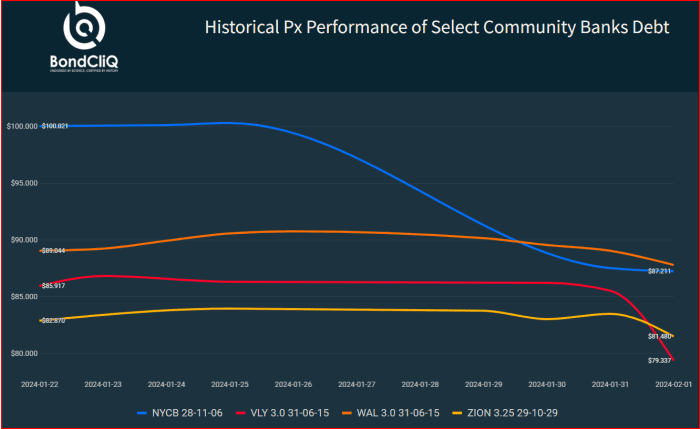The 44% decline in the stock of New York Community Bancorp Inc. this week dragged shares of other small banks lower with it and also had a chilling effect on their bonds.
New York Community Bancorp Inc.’s stock
NYCB,
on Thursday triggered the steepest drop in regional-bank stocks since the collapse of Silicon Valley Bank in March 2023.
The bank stunned markets with its fourth-quarter earnings that showed an unexpected loss, a buildup of its reserves and challenges in the office-space sector with one of two troubled loans. The bank also said it would cut its dividend by more than two-thirds to build up capital to meet regulatory requirements as a larger Category IV bank with assets of $100 billion to $250 billion.
The news raised concerns about smaller banks’ exposure to commercial real estate and the possible need for them to raise loan-loss provisions.
The bank’s single traded bond also fell off a cliff, as the following chart from data-solutions provider BondCliQ Media Services shows. The floating-rate notes, which mature in November 2028, fell a full 12 cents this week to 87.27 cents on the dollar.
New York Community Bancorp notes due Nov. 6, 2028, year-to-date performance.
BondCliQ Media Services
The move weighed on other community banks, too, with Valley National Bancorp’s
VLY,
3% notes that mature in June 2031 also crumbling to 79.34 cents on the dollar. That bank, which operates as Valley Bank, is a regional lender based in Morristown, N.J., with about $61 billion in assets.

Valley National Bancorp 3% notes due June 15, 2031.
BondCliQ Media Services
Other small community-bank bonds were also caught up in the selling, as the following chart illustrates. This one adds bonds issued by Western Alliance Bancorp.
WAL,
a Phoenix-based lender with $70.9 billion in assets as of Dec. 31., and Zions Bancorp N.A.
ZION,
a Salt Lake City-based bank with $87.2 billion in assets.

Historical price performance of select community banks’ debt.
BondCliQ Media Services
The next chart highlights the maturity bucket for those bonds.

Select community banks’ outstanding debt by maturity bucket.
BondCliQ Media Services
Regional banks have a larger exposure to commercial real estate, which has left them vulnerable in the current office-space downturn, Oppenheimer analyst Chris Kotowski said on Friday.
In the case of New York Community Bancorp, about 73% of its loan portfolio has ties to real estate following its acquisition of the distressed Signature Bank last year.
Its loan portfolio in the New York area also includes exposure to multifamily homes with rent regulations as a reality of the local market.
“It just illustrates why small, regional narrow banks are inherently undiversified and in our view a generally flawed business model,” Kotowski said.
For more, read: The small, regional bank business model is unalterably broken,’ says Oppenheimer analyst after New York Community Bancorp stock swoon
The moves also weighed heavily on bank exchange-traded funds. The SPDR S&P Regional Banking ETF
KRE
has fallen 7.4% on the week, and the KBW Nasdaq Bank Index
BKX
is off by 2.4%.









